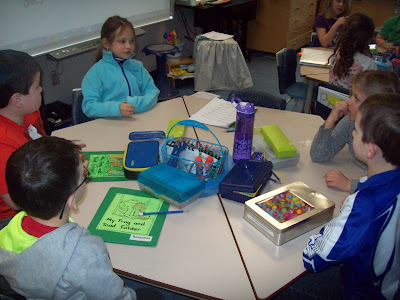We are beginning to work towards visualizing in mathematics. That means that the students, after working with numbers up to 100 for almost five months are asked to 'see' the 100 chart or number line in their head, moving from concrete to abstract. Using our iPad minis, the students worked in pairs to find one more, one less, ten more and ten less than the target number. Here the number was 46. The students practised finding one more and one less than 46. Those numbers are found in the same row as 46. They then practised finding ten more and ten less than 46. Those numbers are found in the same column as 46. Once they were able to do many, many examples, both with a partner and on their own, the hope is that they will be able to find these numbers in their head without a 100 chart in front of them. That is visualizing.
To extend this activity, making it more challenging, the students were given a target number, in this case 73, and asked to find two more, two less, twenty more and twenty less. What thinking would they have to do to be correct? What truth about how numbers work would they have to hinge this new learning onto?
They have had multiple opportunities to see how odd and even numbers form a pattern in our number system. What number always follows an even number? What number always follows an odd number?
In most elementary classrooms, worksheets are not what drive the learning in a math class. Instead, discussions, working with others and manipulatives are the tools for understanding. What you are seeing is the forming of new understanding as this group works together to discuss their plans to solve the problem that is written on the SMARTBoard.
This problem is specifically written to tease out the students who are reading with understanding.
In small groups, the students work together to demonstrate their thinking. They are often asked to prove how they know that their thinking makes sense. The correct answer is not always the goal of the lesson. Being able to explain your thinking so others understand is!
I love when they are confused! It means that their brains are really engaged! They are challenging themselves. It is the #1 goal of education....to think, to figure out, to believe you can!
Thank you again to those parents (and nanas) who came to watch our final assembly. Ask your child why we celebrate Valentine's Day. Who was St. Valentine? What did he do that was special to become a Saint? How can we become saints?
It's our last day of working with the stories of Frog and Toad. One of the stories we read was entitled 'A Swim' The students used plasticine to create an illustration of the setting of the story. They watched a short video of how Barbara Reid how done this technique for her many books. They learned how to mix two colours together to create a new colour and they also had to manipulate the plasticine to cover a large surface area.
They then layered other colours onto the original background of the sky and water.
They added rocks again mixing colours,
showing another part of the scene from the story.
Finally, they used a different technique to roll the clay to create bullrushes or cattails to add detail. Tomorrow, the final aspect, adding the two main characters will complete the scene.
Remember that:
a) Report cards come home tomorrow. So do Literacy Bags. Writing scribblers are due tomorrow.
b) There is no school for students on Friday, but never fear, I'll be at school!
c) Monday - book orders and hot lunch orders are due. Writing scribblers will go home.
d) Teacher's Convention is next Thursday and Friday.
e) The next week we have Shrove Tuesday, Ash Wednesday mass at church, and another PD Day on that Friday.
f) There is no school on Monday, Feb. 15 as it is Family Day.
St. Valentine's Day falls on a Sunday. On Thursday, Feb. 11, the students may bring Valentine cards (for everyone in the class please) and we will do an exchange. As evidenced by our so, so busy month, there just won't be time to have a party. Please understand.































































